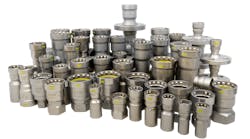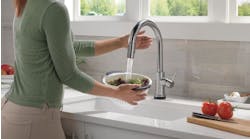We're pleased to report on page 1 and page 3 of this issue about the issuance of draft WaterSense specifications for high-efficiency urinals and for whole-house applications.
According to the EPA, it is considering a maximum allowable flush volume of 0.5-gal. per flush for flushing urinals. The EPA noted that the California Urban Water Conservation Council and a select group of its water provider members developed a similar standard for HEUs in 2004 that is now a widely recognized and accepted standard.
Also under consideration by WaterSense is a requirement that flushometer valves be non-adjustable as to flush volume as well as tamper-proof.
The whole-house WaterSense specification, aimed at builders and developers, is an attempt to push the mainstream homebuilding industry toward more water conservation as a standard practice. Toilets would have to be WaterSense-labeled high efficiency toilets. All bathroom faucets would be WaterSense-labeled bathroom faucets with a maximum flow rate of faucets and aerators at 1.5-gpm at a flowing pressure of 60 psi. Kitchen faucets would have to comply with the Federal limit of 2.2-gpm at 60 psi.
Significantly, the specification would eliminate carwash-like showers and limit total flow from all showerheads and body sprays to no more than 2.5-gpm in a shower compartment that measures 2,500-sq.in. That's the same direction in which the International Association of Plumbing & Mechanical Officials Green Technical Committee is heading and what the committee will likely propose as a change in the Uniform Plumbing Code.
So, while all this is progress in water conservation, what does it mean in practical terms? Not much. WaterSense is an underfunded program that does not get the respect it deserves.
I had the pleasure of meeting the U.S. Environmental Protection Agency's John Flowers, who's regarded as the “father” of the WaterSense program at a water heating forum in Sacramento, Calif. Flowers deserves our praise for the good work that he's done in spite of WaterSense being the stepchild to Energy Star at the EPA.
Case in point. In an open letter to Rick Fedrizzi, president, CEO and founding chairman of the U.S. Green Building Council, Mary Ann Dickinson, the executive director of the Alliance for Water Efficiency, exclaims, “USGBC should accept EPA's WaterSense program as an equal to the EPA/DOE Energy Star program. Giving LEED points for Energy Star labeled products only, while not requiring WaterSense labeled products, isn't logical. They are both national voluntary efficiency programs by the same federal agency! To fully recognize one EPA efficiency program while keeping the other as optional in the background is not acceptable.”
In the letter (to which water conservation expert John Koeller, P.E., contributed heavily), Dickinson notes that LEED for Homes doesn't even require WaterSense 1.28-gpf high-efficiency toilets, “which means that non-WaterSense HETs could be selected that may, in fact, be inferior performers and result in poor customer satisfaction.”
WaterSense gets so little respect that it doesn't even have its own line-item in the EPA budget; the total is reportedly less than $4 million a year.
As it is, the Feds don't enforce the water conservation laws that are on the books now. During a session on shower water usage at the aforementioned water heating forum in Sacramento, a frustrated Sally Remedios, director of compliance for Delta Faucet Co., showed Powerpoint slides of advertising on the Internet for showerheads that put out 10-gpm or that tell consumers that they can remove the flow restrictors from showerheads. Despite U.S. law restricting shower flows to 2.5-gpm, Remedios discovered that only 13 showerhead manufacturers report that they are compliant to the Federal Trade Commission and only 17 manufacturers report compliance to DOE. Nobody looks for scofflaws. DOE says thank you very much and just sticks the reports in a file cabinet.
Even as a voluntary program, if WaterSense got the respect and prominence that it deserves, maybe then people would be embarrassed about 10-gpm showerheads. It would be breaking the social contract, like not picking up after your dog.
We can hope.

